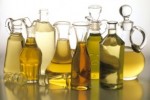Olive oil is the main source of fat in Mediterranean regions and now is becoming very popular among other countries including United States, Argentina, Chile, Mexico, Australia and others. The popularity of this oil is mostly due to its nutritional benefits.
Why is olive oil different from other vegetable oils? First of all, olive fruits are cold pressed, then they are filtered and centrifuged which keeps oil unchanged from that found in the fruit. In contrast, other vegetable oils are obtained by solvent extraction and then refined by processing. Secondly, olive oil is high in monounsaturated fats (contains one double bond on the molecule) which makes it less easy to be oxidized, compared with vegetable oils that has polyunsaturated fats (has many double bonds in the molecule),which makes them more unstable and allows them to oxidize more easily. Additionally, olive oil contains a good amount antioxidants such as of Tocoferol (vitamin E), some pigments, and phenolic compounds that are beneficial to the health and also aid in keeping the oil from oxidation. Many of us try to use virgin olive oil in our salads, but sometimes we also use it to sauté or stir-fry, with the hope that heating does not completely reduce healthy benefits of the oil. Or does it?
This question was examined by Santos et al in the latest research that was published at the Food Research International magazine. The research team examined the effect of cooking on olive oil quality. Scientists looked at several ways of cooking, including frying (deep-frying, pan-frying), roasting, microwaving and boiling the olive oil.
Frying: Frying changes oil compounds by oxidation, hydrolysis and polymerization (basically degrades them). What is interesting is that it is not equivalent for all vegetable oils, with olive oil being one of the most stable against oxidation due to having monounsaturated fats. Using olive oil for deep-frying at 180oC showed to be oxidation–stable. Actually, the oxidation score of sunflower oil after deep frying for 3 hours was equivalent to the score of deep frying olive oil after 27 hours. That indicates that olive oil for deep-frying is at least 9 times as stable as sunflower oil. Does it mean I could deep-fry my food for 27 in olive oil without changing it? – Probably not, because the study was heating oil without any food in it. Food and liquids (such as juices of meat or veggies) will increase oxidation reaction and degradation of the oil. But even with that in mind, olive oil is shown to be the most resistant to degradation.
Interestingly, some studies showed that replenishing (or adding up) olive oil during deep-frying will help oil to hold up longer. That is not a surprise, as a new pool of protective compounds would help to increase the amount of time before oil molecules will be broken down. Also olive oil contains the lowest amount of vitamin E of all vegetable oils; it is the slowest to be lost during heating (170-180 C, 3-6h) compare to other vegetable oils.
What may be surprising is that frying foods or just heating olive oil on the pan will cause oil to lose vitamin E, phytosterol, phenolic compounds and degrade much faster than if the oil was deep fryed. The reason for that could be higher food:oil contact surface, higher exposure to the oxygen, and lower temperature control. The good news is that foods that were fried in olive oil were found to be enriched in olive oil antioxidants, as long as olive oil was not overheated during the pan-frying.
Roasting: Roasting olive oil, especially in conventional ovens, is shown to be even higher in oxidation and degradation of monounsaturated fats. It is suggested that this could be due to the higher surface area exposed to hot air. Still, olive oil showed to be the most resistant to oxidation compared with other vegetable oils. Also no difference was found between using Extra Virgin, Virgin Olive oil or just Olive oil in the roasting experiment. Therefore, it could be a good idea to use cheaper olive oil for your roasting. As for the antioxidants, study showed that heating olive oil 180 oC for 2 hours will reduce tocopherol and polyphenol.
Microwaving: The frequencies that were used for microwaving were 2450 MHz, powers were tested from 500W to 1100W. When comparing microwaving olive oil to conventional heating, the microwaving oil showed higher amounts of oxidation and degradation in the shorter period of time (only after 15 min). But again, if to compare olive oil microwaving to any other vegetable oil microwaving, the olive oil will be more resistant to degradation. Another point authors made is that power rather than the time can contribute to degradation of the oils. By reducing the power you can save olive oil from excessive oxidation and degradation.
Boiling: Boiling olive oil such as in soups or stewing usually does not increase temperature of olive oil higher than 100 oC, which reduces the risk of oxidative stress. But, since oil is in the interaction with water another risk, hydrolysis, is increased. Some water soluble nutrients can be leached out from the oil, which should not be very disturbing news, since it is still going to stay in the broth of your meal. As in the roasting of olive oil, the authors suggest to use Olive oil instead of Virgin or Extra Virgin versions of it, since there were no nutritional differences found after boiling between the three types. Additionally, it was recommended to add olive oil 15 min before concluding your meal, to prevent loss of nutrients.








I think I will only use extra virgin olive oil from now on.
[...] Meat is an important source of B-vitamins and some minerals. Meat is also a source of saturated and polyunsaturated fats. Often while calculating the nutrients consumed, the nutrients are calculated from the raw meat, which is not the same as in prepared meats. Most of us heard that meats are high in saturated fats that may contribute to the heart and vascular diseases. Well, according to the Meat Science journal, cooked meats have less saturated fat and they also have a better ratio of fats with high polyunsaturated/saturated. Geber et al. suggest that this could be due to triglycerides tending to leach and melt into drippings during the cooking. Thus, if you don’t plan to consume fatty drippings on the bottom of your pan, you are consuming more polyunsaturated fats (such as omega-6 and omega-3) than saturated fats. The total amount of fat (saturated, poly- and monounsaturated fats) was decreased significantly 18-44%, due to the melt of fat during cooking. And if the meat was trimmed prior to cooking, your consumption of saturated fats decreases even more. Though this might be true, the polyunsaturated fat in the meat can be at risk of oxidation (read more on this topic). [...]